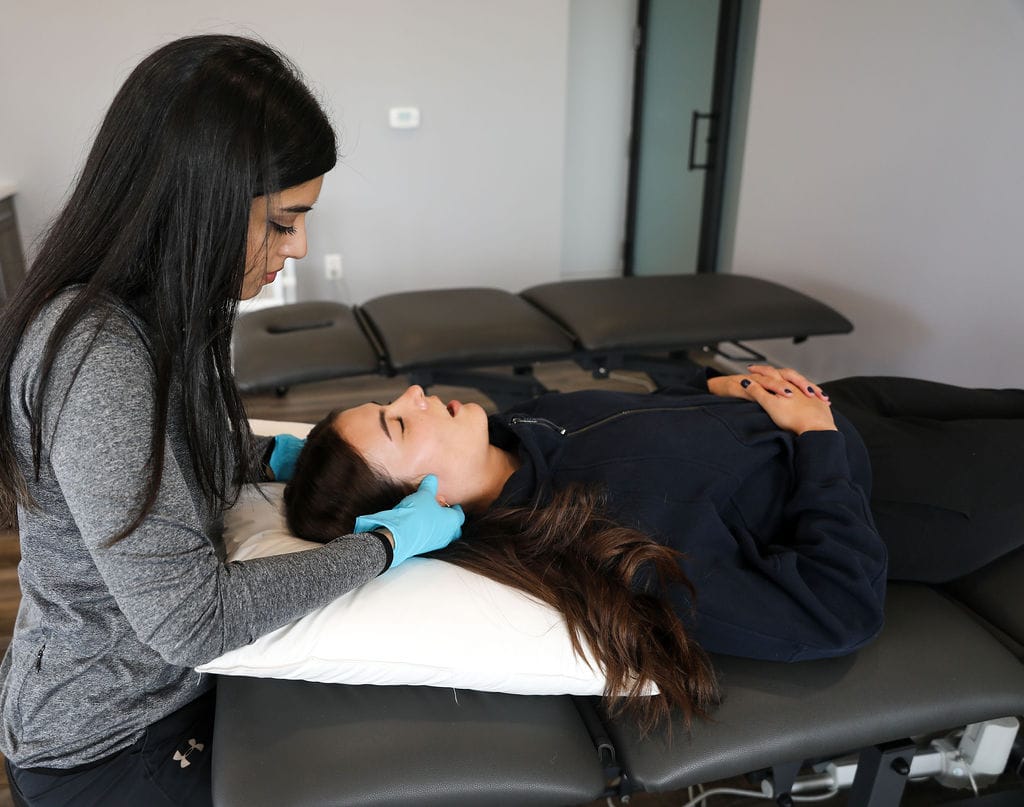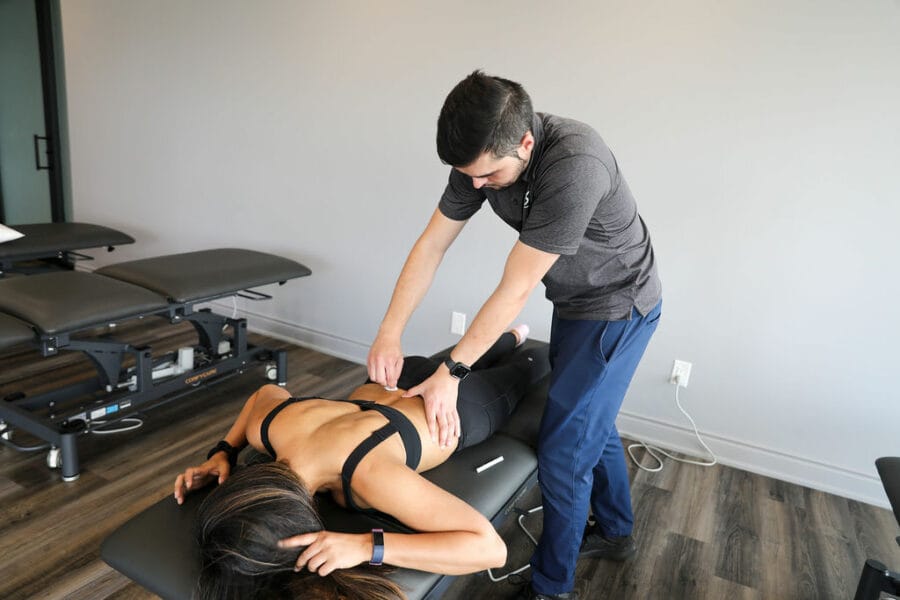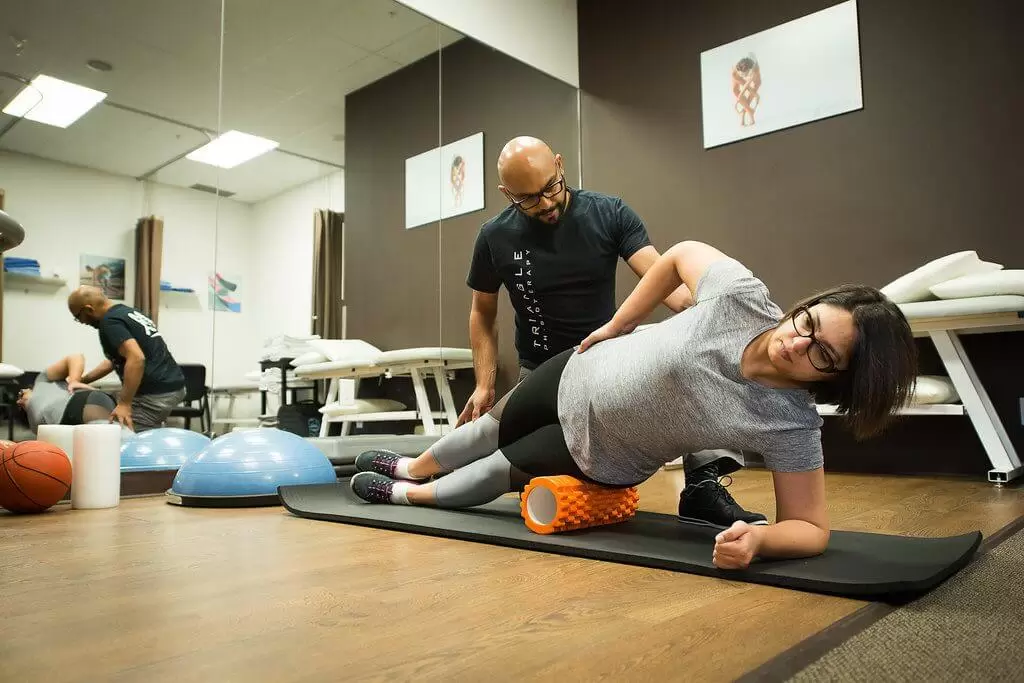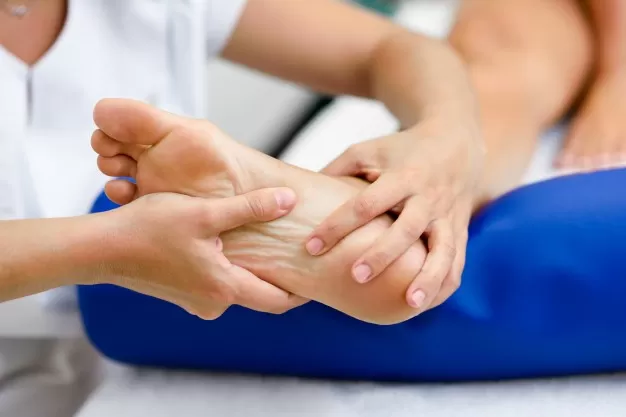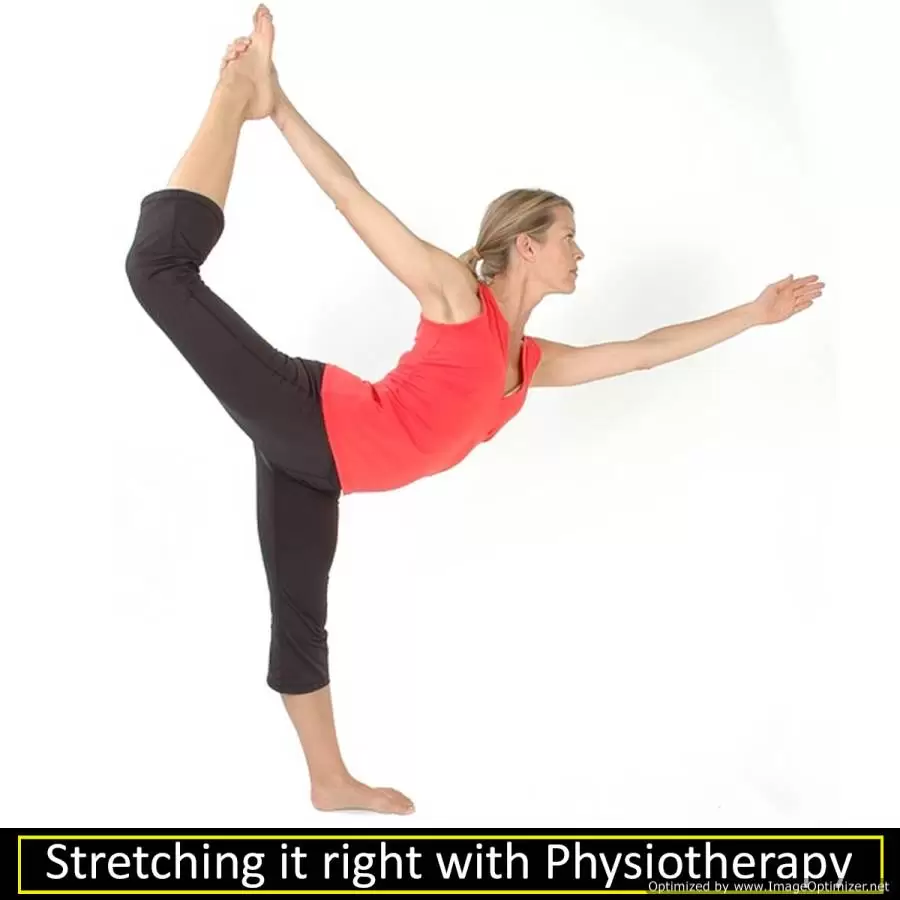Chiropractic care focuses on the diagnosis and treatment of mechanical disorders of the musculoskeletal system, particularly the spine. Chiropractors use manual manipulation and other techniques to treat conditions such as back pain, neck pain, headaches, and other musculoskeletal issues. While chiropractic care may benefit some individuals, it’s essential to note that its effectiveness can vary from person to person, and it may not be suitable for everyone.
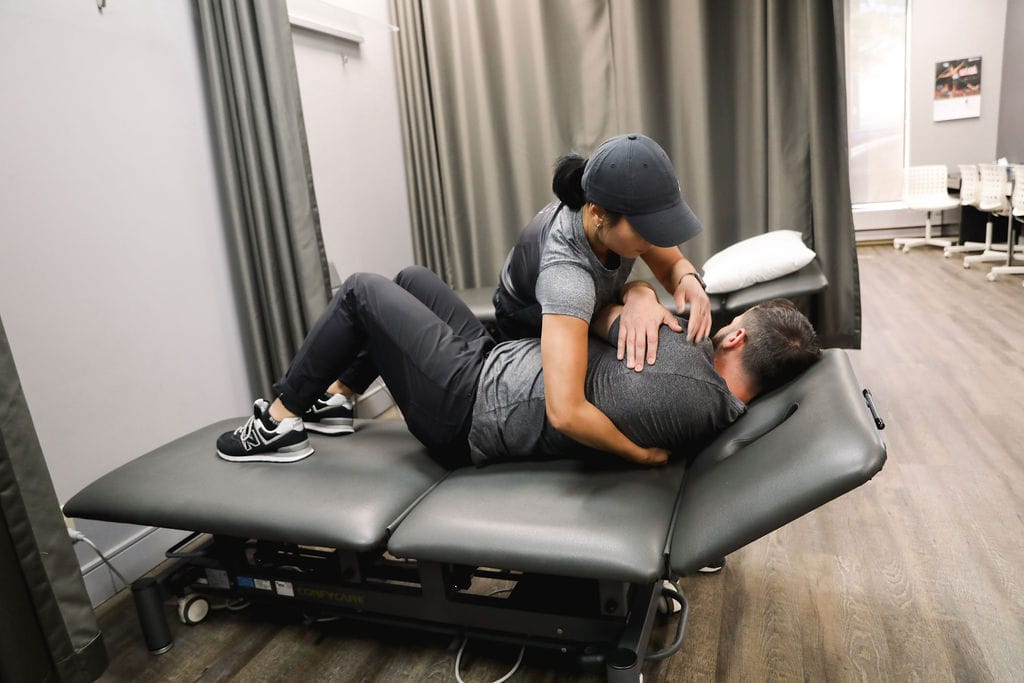
Here are some groups of people who may potentially benefit from chiropractic care:
- Individuals with Back Pain: Chiropractic care is often sought by people experiencing acute or chronic back pain. Spinal adjustments performed by chiropractors may help alleviate pain and improve mobility.
- Neck Pain Sufferers: Chiropractic adjustments may also be used to address neck pain, especially if it is related to issues with the cervical spine.
- Headache and Migraine Sufferers: Some people find relief from headaches and migraines through chiropractic care, particularly if the issues are related to tension or misalignments in the spine.
- Joint Pain and Mobility Issues: Chiropractors may work on various joints in the body, not just the spine. People with joint pain or mobility issues in the shoulders, hips, knees, or other joints may seek chiropractic care.
- Sports Injuries: Athletes often turn to chiropractors for the treatment of sports-related injuries. Chiropractic care may help with the recovery process and improve overall athletic performance.
- Pregnant Women: Some pregnant women seek chiropractic care to help manage musculoskeletal changes that occur during pregnancy. Chiropractors may use gentle techniques to address discomfort and pain.
- Postural Issues: Individuals with poor posture or those whose daily activities contribute to spinal misalignments may benefit from chiropractic adjustments to improve posture and prevent associated issues.
- Chronic Conditions: While chiropractic care is not a cure for chronic conditions, some individuals with conditions like osteoarthritis or fibromyalgia may find relief from certain symptoms through chiropractic treatments.
What is the treatment approach of the chiropractors at Triangle Physiotherapy?
The chiropractors at Triangle Physiotherapy have a rehab-focused approach to treatment. They believe in evidence-based treatment solutions are are able to carry forward the treatment plan proposed by your physiotherapist.
How do I book an appointment with a chiropractor near me?
Click HERE to book an appointment with a chiropractor at one of our eight locations.
- Chiropractor Etobicoke – Triangle Physiotherapy Etobicoke
- Oakville Chiropractic Clinic – Triangle Physiotherapy Oakville
- Chiropractic North York – Triangle Physiotherapy North York
- Mississauga Chiropractic Clinics – Triangle Physiotherapy Mississauga
- Downtown Chiropractic Clinics – Triangle Physiotherapy King West
- Uptown Chiropractic Clinics – Triangle Physiotherapy Lawrence Park
- Chiropractic Clinic Downtown Toronto – Triangle Physiotherapy Queens Quay
- Chiropractor Mississauga – Triangle Physiotherapy Erin Mills
Chiropractic care can benefit individuals dealing with back pain, joint issues, and overall mobility concerns, often working well in conjunction with physiotherapy. If you are looking for professional physiotherapy services to complement your chiropractic care, there are clinics in physiotherapy Etobicoke, Oakville, North York, Toronto, Lawrence Park, Queens Quay, Erin Mills, Mississauga, and Liberty Village. These locations offer comprehensive care and personalized treatment plans to help you achieve optimal health and wellness.
Q: Why do I experience back pain while working from home?
A: Back pain during work from home can be caused by various factors. Some common reasons include:
- Poor posture,
- Inadequate ergonomics,
- Prolonged sitting,
- Lack of physical activity, and
- Stress
Working from home often means using suboptimal workstations, such as sitting on a couch or using a kitchen table as a desk, which can contribute to poor posture and strain on the back muscles.
Q: How can I improve my posture while working from home?
A: Improving your posture can help reduce back pain. Here are some tips:
- Use a comfortable chair with good lumbar support.
- Sit up straight and align your head, neck, and spine.
- Keep your feet flat on the floor or use a footrest if needed.
- Position your computer monitor at eye level to avoid straining your neck.
- Take breaks and stretch regularly to prevent prolonged sitting.
Q: What are some ergonomic recommendations for a home office setup?
A: Consider the following ergonomic recommendations for a home office setup:
- Invest in an adjustable chair with proper lumbar support.
- Use a desk or workstation at an appropriate height to maintain proper alignment.
- Position your keyboard and mouse at a comfortable distance and height.
- Ensure your computer monitor is at eye level and about an arm’s length away.
- Use a document holder if you frequently refer to papers or documents.
- Consider using an ergonomic keyboard and mouse to minimize strain on your hands and wrists.
Q: How can I incorporate physical activity into my work-from-home routine?
A: Adding physical activity to your work-from-home routine can help alleviate back pain. Here are some suggestions:
- Take short breaks every hour to stretch and move around.
- Incorporate exercises such as walking, jogging, or cycling into your daily routine.
- Consider using a standing desk or an adjustable desk converter that allows you to alternate between sitting and standing.
- Engage in exercises specifically targeting core strength and back muscles, like yoga or Pilates.
- Schedule regular exercise breaks or participate in online workout classes during your breaks.
Q: Are there any specific exercises that can help relieve back pain while working from home?
A: Yes, certain exercises can help relieve back pain. Here are a few examples:
- Cat and Camel
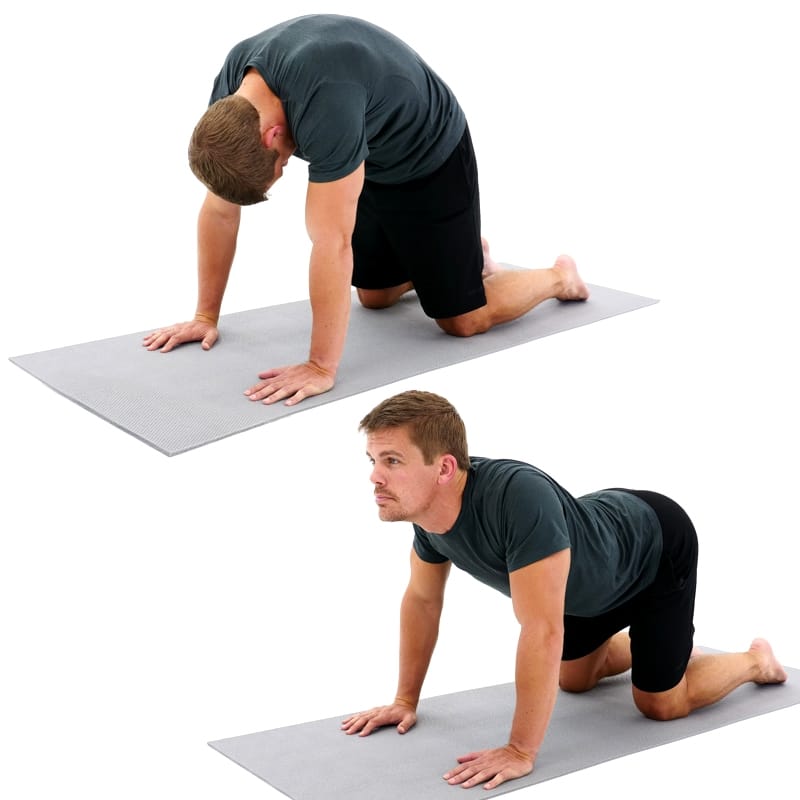
Get on your hands and knees, arch your back upward like a cat, then lower it down like a camel.
2. Back Extensions
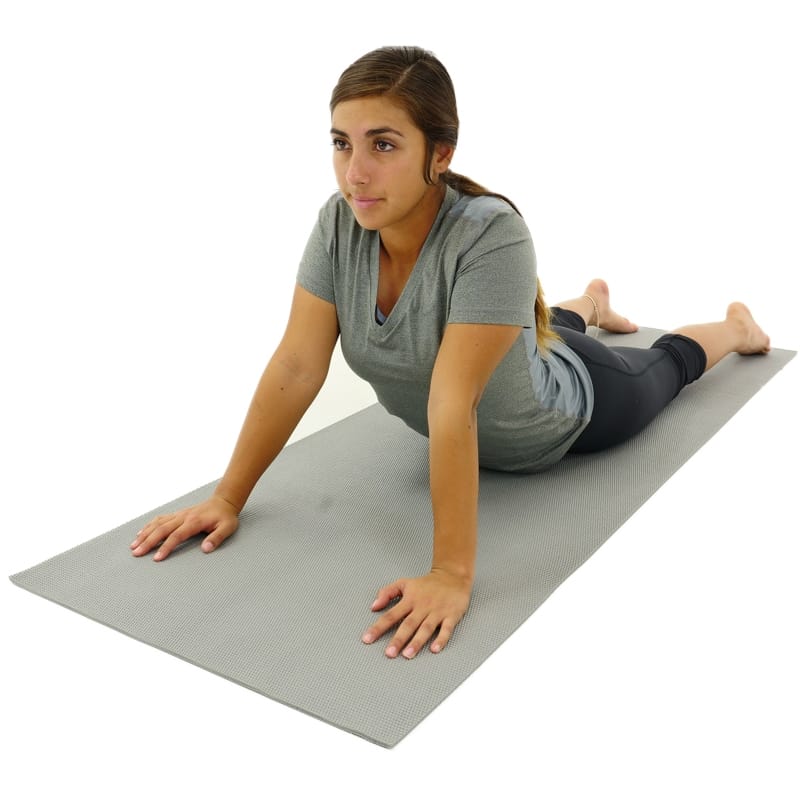
Lie face down, place your hands under your shoulders, and slowly lift your upper body off the ground while keeping your pelvis on the floor.
3. Bridge Pose
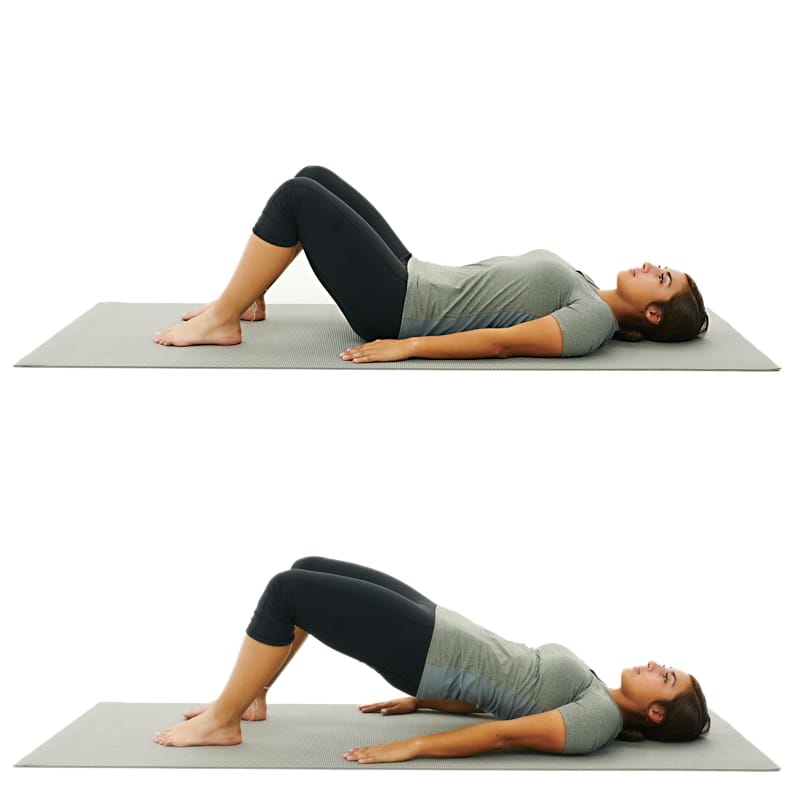
Lie on your back with your knees bent, feet flat on the floor. Lift your hips off the ground, forming a straight line from knees to shoulders.
4. Child’s Pose
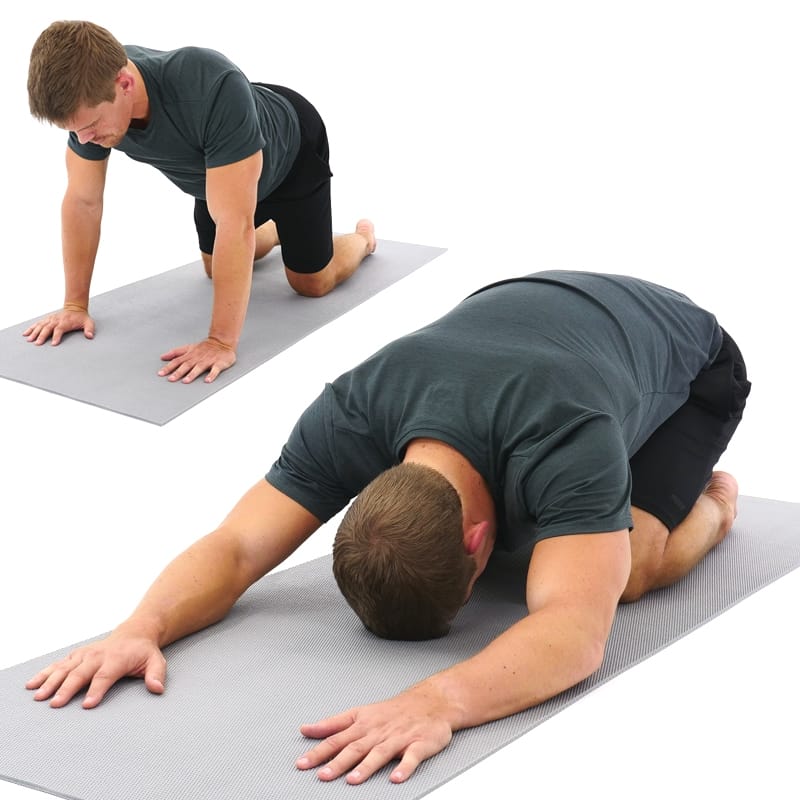
Kneel on the floor, then sit back on your heels while lowering your upper body forward, reaching your arms out in front of you.
Remember to consult with a physiotherapist for personalized advice on exercises and stretches for your specific condition.
Q: How can I manage stress-related back pain while working from home?
A: Stress can contribute to back pain. Here are some strategies to manage stress:
- Practice relaxation techniques such as deep breathing exercises, meditation, or mindfulness.
- Maintain a healthy work-life balance by setting clear boundaries between work and personal time.
- Engage in stress-reducing activities outside of work, such as hobbies, exercise, or spending time
Click HERE to book an appointment with a physiotherapist at one of our eight locations.
- Physiotherapy Etobicoke – Triangle Physiotherapy Etobicoke
- Oakville Physiotherapy Clinic – Triangle Physiotherapy Oakville
- Physiotherapy North York – Triangle Physiotherapy North York
- Mississauga Physiotherapy Clinics – Triangle Physiotherapy Mississauga
- Downtown Physiotherapy Clinics – Triangle Physiotherapy King West
- Uptown Physiotherapy Clinics – Triangle Physiotherapy Lawrence Park
- Physiotherapy Clinic Downtown Toronto – Triangle Physiotherapy Queens Quay
- Physiotherapy Clinics Mississauga – Triangle Physiotherapy Erin Mills
“Working from home can lead to back pain, but with the right strategies and physiotherapy, you can find relief. Triangle Physiotherapy offers expert services across the GTA, including Physiotherapy in Etobicoke, Oakville, North York, Toronto, Lawrence Park, Queens Quay, Erin Mills, Mississauga, and Liberty Village. Our experienced physiotherapists can help you develop a personalized plan to manage and prevent back pain while working from home.”
Pelvic Floor Disorders are a common occurrence but the treatments available for pelvic floor dysfunction are not widely known. Pelvic Floor Physiotherapy has been proven to help with Pelvic Floor Dysfunction and this is where we come in! Triangle Physiotherapy has state-of-the-art facilities with private rooms for pelvic health treatments. Your comfort is our priority while addressing this sensitive issue.
Pelvic Floor Muscles & Pelvic Floor Dysfunction
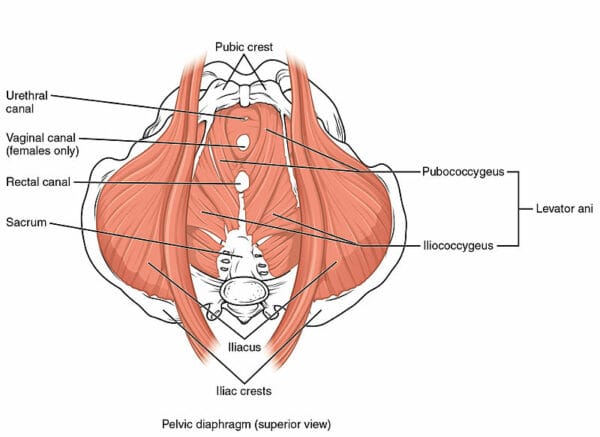
The pelvic floor is made up of layers of muscles and other tissues. These muscles are stretched end to end from the tailbone to the pubic bone. Sometimes these muscles tend to lose their normal control and cause pelvic floor dysfunction.
Also read, Physiotherapy Clinic in Etobicoke
What causes Pelvic Floor Dysfunction?
Pelvic Floor Dysfunction can be caused by any of the following two conditions:
- Hypotonicity – When the pelvic floor muscles become weak and are unable to continue proper functioning, they cause stress incontinence, urge incontinence and pelvic organ prolapse (when a pelvic organ drops from its normal position).
- Hypertonicity – When the pelvic floor muscles become tight, leading to urinary and fecal urgency, urge incontinence, chronic pelvic pain, etc., the condition is known as pelvic floor dysfunction.
Also read, Physiotherapy Treatment in Oakville
What Do We Treat?
We treat a variety of Pelvic Floor Dysfunctions such as:
Conditions in Males
- Post-Prostatectomy Incontinence
- Pelvic Pain
- Pelvic Floor Dysfunction
Conditions in Females
- Pelvic Organ Prolapse
- Vaginal Pain Syndrome
- Urinary Conditions
- Pelvic Floor Dysfunction
Musculoskeletal Conditions
- Lower Back Pain
- Groin/Pubic Pain
- Sacroiliac Pain
- Piriformis Syndrome
Also read, Physiotherapy Mississauga
Rectal & Bowel Conditions
- Constipation
If you suffer from any of the above-mentioned conditions, you should consider booking an appointment at any one of our 6 clinics in Etobicoke, Oakville, Mississauga, North York, Toronto (King Street) and Toronto (Yonge Street).
How can Pelvic Physiotherapy help me?
Pelvic Floor Physiotherapy can help you with:
- Pelvic exercises to gain bladder and bowel control.
- Exercises to regain normal muscle strength and tone.
- Manual Therapy techniques to help you locate & work your weak pelvic floor muscles.
- Tips on good postures.
- Identification of other problem areas that might need physiotherapy treatment.
- Appropriate lifestyle guidance and recommended changes.
Pelvic Physiotherapy is an effective treatment for solving Pelvic Floor Dysfunction and at Triangle Physiotherapy, our Pelvic Physiotherapists will help you get back to doing the things you love.
Pelvic floor physiotherapy is an essential treatment for those experiencing pelvic discomfort, incontinence, or postpartum recovery challenges. If you are looking for professional physiotherapy services, there are clinics in physiotherapy Etobicoke, Oakville, North York, Toronto, Lawrence Park, Queens Quay, Erin Mills, Mississauga, and Liberty Village that offer specialized care and customized treatment plans to help improve pelvic health and overall quality of life.

Some common winter sports injuries:
1) Separated shoulders
2) Knee Sprains
3) Torn ligaments
4) Pulled muscles
5) Fractures
Also read, Etobicoke Physiotherapy Clinic
Exercising alone isn’t enough to achieve good health if you’ve already had an injury. It’s important to address injuries before they worsen and become more difficult to manage. At Triangle Physiotherapy, we promote active treatment programs that emphasize exercise to encourage client participation & independence.
Overcoming winter aches and pains:
Sometimes, a change in the weather could cause dormant aches to become more apparent. Joint pain can occur anytime throughout the year, but in the cold and wet months of the winter, you may find it harder to cope with.
A visit to a physiotherapist can help to keep you moving forward in a pain-free manner.
- Avoid excess twisting and forward bending. Bend the knees and keep the back as straight as possible when you are lifting.
- Make sure that you are using proper techniques and good body mechanics to help you avoid shoulder and low back injuries can be avoided.
- Don’t let the cold weather put you off – bundle up and be careful in wet or icy conditions.
- Exercising regularly will help reduce pain within your joints and help prevent other health issues.
- Also, ensure that you don’t overdo exercise if you are new in the sphere. Make sure you warm up with a brisk walk or gentle jogging.
Also read, Physiotherapy Treatment in Oakville
When our body is cold, it restricts the amount of blood it sends to our extremities, like our hands and feet, so that it can focus on supplying vital organs (like the heart and lungs) with blood. This means that we lose less heat from blood circulating near the surface of the skin, and also means that the joints get less blood. This can cause delayed healing and an increased insensitivity to pain.
To answer all of your queries in detail, we, at Triangle Physiotherapy thoroughly assess you and create customized treatment programs that address each individual’s needs. There are many people who feel depressed during the winter months, which can increase their sensitivity to pain. Don’t let your passion for living a pain-free life take a back seat during the winter season!
Triangle Physiotherapy is coming up with a new health campaign called #JoinTheMovement. By participating in this movement, you will notice a significant difference in your overall health awareness and awareness of what a Physiotherapist can do for you.
So, what are you waiting for? For more information on our services, visit our pages on facebook, and instagram
Winter can increase the risk of slips and falls, making physiotherapy essential for recovery and injury prevention. If you are looking for expert physiotherapy services, there are reputable clinics in physiotherapy Etobicoke, Oakville, North York, Toronto, Lawrence Park, Queens Quay, Erin Mills, Mississauga, and Liberty Village. These clinics provide specialized care and tailored treatment plans to help you stay safe and active throughout the winter season.
What do we mean by Sports Injuries? Any sort of injury that is caused when we get too involved and carried away in the spirit of any sport. When the passion is high, and the energy is there we tend to suffer from small accidents related to Knee pain, Elbow, etc.
What qualifies as a Sports Injury?

It’s any type of injury that might arise from getting too involved and carried away in the spirit of any sport. In the heat of the moment during a sports game, it is easy to ignore smaller annoyances that might progress to become significant sources of pain.
Also read, Physiotherapy Oakville
So, what do many people do when they inevitably suffer a sports injury?
The most common answer is to go and visit a doctor. However, we tend to forget that the most effective and immediate assistance we can get is from a physiotherapist. Reducing swelling and providing pain relief are usually the first steps that a physiotherapist will take to promote recovery after an injury.
Advanced progression of the treatment plan usually involves techniques like stretching and providing range of motion and strengthening exercises that are meant to help the injured person regain strength and balance. The physiotherapist will also ensure that you don’t push yourself too far or too fast, thereby helping you prevent re-injury.
Below are some common questions and answers that might be relevant to you:
Who is better equipped to diagnose my injury – a doctor or a physiotherapist?
Both doctors and physiotherapists have the necessary skills to diagnose your injury. Interestingly the most important thing is that there is a DIAGNOSIS made!
Who is better equipped to manage/treat my injury – a doctor or a physiotherapist?
Well, it depends on the injury. For example, it is not uncommon for a physiotherapist to refer a patient to a doctor to ask for a prescription for some anti-inflammatory medication as these are not able to be prescribed by a physiotherapist. However, a physiotherapist will generally provide more detail regarding the injury, as well as provide manual treatment and prescribe a detailed exercise program for the patient that will help promote recovery.
Also read, Physiotherapy Clinic Mississauga
When do I need to consult a physiotherapist?
There are many other conditions apart from sports injuries that would require treatment from a physiotherapist. Some of them are:
- Any arthritic conditions
- Treatment of pelvic floor disorders
- Chronic/Overuse injuries
- Muscle or joint issues that might arise during pregnancy
- Vestibular conditions
- Various other muscle strains and sprains
Any of the above-mentioned problems should be treated immediately in order to prevent further aggravation of the condition! Seek the help of our specialists at any of our locations in Etobicoke, Oakville, North York, Mississauga & Toronto, and get rid of such dilemmas!
Who is a Podiatrist? A podiatrist deals with the assessment, diagnosis and treatment of the lower limbs and feet. What is a Chiropodist? A chiropodist deals with the assessment, diagnosis and treatment of the lower limbs and feet. Sound familiar? That is because these two professions are one and the same!
While there may be differences in terms of scope of practice in other areas of the world, in Canada, both podiatrists and chiropodists are qualified to treat patients with arthritis, diabetes, lower limb sports injuries, and various other ailments of the feet. They have received specialized training which allows them to work with patients of all ages and to help the elderly stay mobile and independent. The only practical difference between the two professions, in terms of their scope of practice in Canada, is simply their title.
Also read, Physiotherapy Treatment Etobicoke
Chiropodists can advise patients on how to look after their feet and what type of shoes or orthotics to wear. They can also treat, alleviate and benefit day-to-day foot conditions, such as:
- Thickened, fungal, or ingrown toenails
- Varicose veins
- Athlete’s foot
- Smelly feet
- Dry and cracked heels
- Flat feet
- Bunions
- Heel pain
- Ageing feet
- Blisters
- Gout
- Sports Injuries
Also read, Oakville Physiotherapy Rehab Clinic

Seek help from a Chiropodist for advice or treatment if you have:
- Painful heels or arches
- Thickened or discoloured toenails
- Cracks, cuts, or hardened skin on your feet
- Growths, such as warts
- Scaling or peeling on the soles
- Any other foot condition
Don’t bury your head in the sand and ignore small foot problems! These small “problems” can quickly transform into major issues that can affect the quality of your life. As they say, “Prevention is the best cure“. Patients who make regular check-up appointments can avoid many potential foot problems as Chiropodists are specialists at recognizing problems before they have occurred.
Don’t let your feet problems keep you from stepping into our clinic! Seek the help of our foot specialists at any of our locations in Etobicoke, Oakville, North York, Mississauga & Toronto, and say goodbye to your foot dilemmas!
Addressing foot problems effectively often requires a comprehensive approach that includes professional physiotherapy. If you need expert care for foot-related issues, there are clinics in physiotherapy Etobicoke, Oakville, North York, Toronto, Lawrence Park, Queens Quay, Erin Mills, Mississauga, and Liberty Village. These locations provide specialized physiotherapy services and personalized treatment plans to help you get back on your feet and improve your overall mobility.
Are your worries all perched on a pillow? And we don’t mean figuratively, but literally, are your worries all about THE PILLOW? Well, you are not in as uncommon a dilemma as you may think. Physiotherapists frequently get queries about pillow-related problems.
Sleeping on the wrong pillow, or one that is too worn out, not only leads to headaches, backaches, and neck cramps but also prevents you from getting a good night’s sleep. Lack of proper sleep can lead to many serious health issues, like obesity, heart disease, diabetes, etc.
It is imperative that you choose the right pillow for yourself but the kind of pillow you should pick will depend on your own unique needs as well. A physiotherapist is the best person to tell you exactly what you need. However, here are a few things that you can keep in mind while making a choice –
- Your usual sleeping position
- The shape and size of your head, neck and back
- Desired softness/firmness of the pillow
- Any neck pain, or backache you may have
- And your budget

Also read, Physiotherapy Clinic in Mississauga
There are a plethora of pillows in the market – cotton, polyester, feather, down, memory foam etc. However, these don’t cater to specific support or pain needs. If you have been injured, or have a particular condition, you will need a pillow that caters best to not just your problem, but also the stage that you are in. There are three main stages –
- Accommodation
- Correction
- Maintenance
For each of these three stages, you will need a specific kind of pillow.
Accommodation Stage:
Specialty pillows that are designed for the ‘Accommodation’ stage, are pillows that bring in comfort and ease by providing support and stabilizing the existing ailment or disorder. Such pillows are often called Displacement pillows and are often recommended by physiotherapists for short-term pain relief after an injury.
Correction Stage:
The next stage of an issue or injury is ‘Correction’. At this stage, a doctor or physiotherapist attempts to find a remedy for the cause of the problem, and thereby correct it. Pillows recommended in this stage are often designed to provide support, and sometimes to even change the sleeping position of the injured or ailing person. There are various ‘Supportive’ pillows to meet different support levels, firmness and neck lobe size needs of different patients. There are also specialized ‘Corrective’ pillows, which can reduce headaches, neck pain, joint pain, and whiplash discomfort and can even improve nerve function. A physiotherapist can tell you what is the ideal Supportive or Corrective pillow you need, based on your health and body needs.
Also read, Physiotherapy Clinic Oakville
Maintenance Stage:
Pillows for the last stage, ‘Maintenance’, help to promote good health by returning and keeping the body in its natural alignment. At this stage maintaining the normal curvature of the neck and spine is of utmost importance. While the normal curvature of one person’s neck and spine may differ from another, there are some general guidelines that a physiotherapist can jot down to help you understand your needs better. Comfort and support are the most important of these.
There are also Aqua pillows, which perform all the 3 functions of a pillow:
- Accommodation: Since water is fluid, a person gets customized accommodation that happens in real time, as the individual changes their position on the pillow.
- Correction: The volume of water determines the firmness and density of the pillow, which means different amounts of water can be utilized to help correct the neck position of different people in different stages of healing.
- Maintenance: Since the volume of water remains constant until changed manually, it helps maintain the neck posture at all times while sleeping.
A lot of people buy a pillow, try it for a few nights, and then feel it isn’t right for them. Sometimes the pillows can be returned, but more often, people end up having a collection of pillows that they have hardly ever used. An Aqua pillow is a huge savior in this aspect, as it can be customized for each individual! The water levels can be modified to best suit the clinical condition, neck shape, and size, and preferred sleeping position of the buyer.
There are also specially designed Orthopaedic pillows for specific conditions like arthritis, fractures, and slip discs. A physiotherapist can enlighten you more about these.
Seek the help of our professionals at any of our locations in Etobicoke, Oakville, North York, Mississauga & Downtown Toronto, and say goodbye to your pillow problems!
Proper posture and support are essential for preventing discomfort and maintaining spinal health. For those seeking professional physiotherapy services to address posture-related issues, consider visiting clinics in physiotherapy Etobicoke, Oakville, North York, Toronto, Lawrence Park, Queens Quay, Erin Mills, Mississauga, and Liberty Village. These clinics offer expert care and tailored treatment plans to help you improve your posture and overall well-being.
Who doesn’t want to stay flexible, especially as they age? Well, stretching is one very good way to stay flexible! According to the American College of Sports Medicine, it’s good to stretch all the major muscle groups at least two times a week. Stretching is an integral part of physiotherapy, and a physiotherapist is the perfect person to guide you on how to stretch. Physiotherapists recommend stretching regularly, as it keeps one’s hips and hamstrings flexible later in life, which is very important for easy movement in old age.
Apart from this stretching has many other benefits:
- It increases muscle flexibility
- It improves posture
- It also improves performance in sports & other activities
- It provides relief from stress
- It helps prevent injuries
- It prevents Delayed Onset Muscle Soreness or DOMS, which is the soreness and pain one suffers a few hours to a few days after hectic exercise.
Also read, Physiotherapy Etobicoke
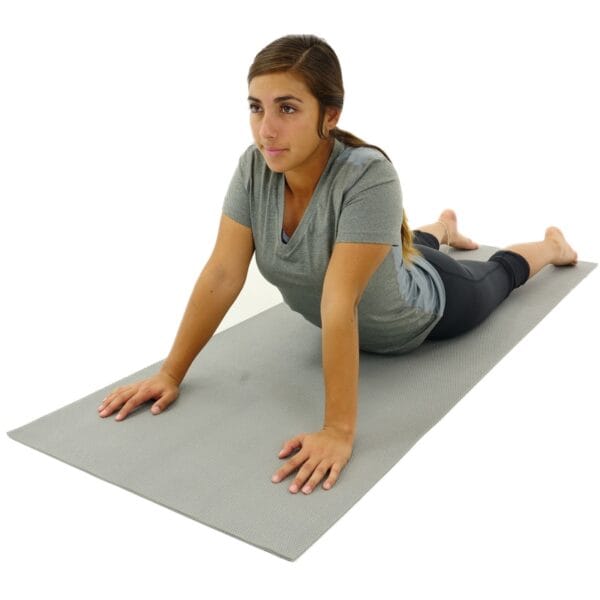
The first question that many wonder about, is what body parts should one stretch.
In physiotherapy, stretching the following body parts is considered essential –
- Neck
- Jaw
- Upper Back
- Shoulders
- Triceps
- Biceps
- Wrists
- Quadriceps
- Calves
- Hamstrings
- Hips
- Groin
The next thing to take into consideration is if there is the right amount of time to stretch. While there is no particular amount of time that physiotherapists suggest you stretch, recent studies show that 3 sets of 30-second stretches, 5 days per week for 4 weeks help to strengthen hamstring muscles greatly.
Also read, Physiotherapy Treatment Oakville
There are many kinds of Stretching that physiotherapists recommend.
Stretching a muscle to its full extent and holding it for 15 to 30 is known as the Static Stretch. You can exceed this time frame a bit but don’t stretch until it hurts, as you can end up doing more damage to your muscles than good by over stretching. However, don’t do Static Stretches before a run or sprint, as this can slow down your speed by tiring out the muscles.
Before warming up for a run or other sports, doing Dynamic Stretches is more suitable. Dynamic Stretches are stretches that you do, as you are moving, and hence are called dynamic.
Another effective way of stretching, often used in physiotherapy, is Proprioceptive Neuromuscular Facilitation (PNF) Stretching.
PNF stretching is an advanced type of stretching wherein the targeted muscle or muscle group, is stretched, contracted, and finally relaxed. This process is repeated at least 2 to 4 times before moving on to the next muscle group. PNF stretching helps to elongate one’s muscles and was first developed as a muscle therapy by athletes, but is now often used in physiotherapy as a means of increasing flexibility.
Stretching can be used as a preventative precaution, but also to help correct and recover from more serious issues. A physiotherapist can guide you more regarding the stretching exercises that will be best suited to your needs. So visit any of our locations in Etobicoke, Oakville, North York, Mississauga & Toronto, and find out how you can get the most out of stretching!
Stretching with physiotherapy can help improve flexibility, prevent injuries, and enhance overall physical performance. If you’re looking for professional physiotherapy services to guide you in safe and effective stretching techniques, there are clinics in physiotherapy Etobicoke, Oakville, North York, Toronto, Lawrence Park, Queens Quay, Erin Mills, Mississauga, and Liberty Village. These clinics provide expert care and personalized treatment plans to help you achieve your mobility and wellness goals.
Do your legs tingle, become numb, or feel weak? You may be experiencing Sciatica. The term Sciatica describes leg pain that originates from the lower back and travels through the buttock and down the large sciatic nerve in the back of each leg. Sciatica is not a medical diagnosis in and of itself –it is a symptom of an underlying medical condition. Common lower back problems such as: lumbar herniated disc, degenerative disc disease, and spondylolisthesis can cause sciatica symptoms.
Sciatica is often characterized by one or more of the following symptoms:
• Constant pain in only one side of the buttock or leg (rarely in both legs)
• Pain that becomes worse when sitting
• Leg pain that is described as burning, tingling, or searing
• Weakness, numbness, or difficulty moving the leg, foot, and/or toes
• A sharp pain that may make it difficult to stand up or walk
• Pain that radiates down the leg and possibly into the foot and toes
Physiotherapy exercises incorporating a combination of strengthening, stretching, and aerobic conditioning are a central component of almost any sciatica treatment plan.
• Strengthening exercises- Most of these back exercises focus not only on the lower back, but also the abdominal muscles, and the buttock and hip muscles.
• Stretching exercises- Stretches for sciatica are designed to target muscles that cause pain when they are tight and inflexible.
• Low-impact aerobic exercise- Some form of low-impact cardiovascular exercise such as: walking, swimming, or pool therapy is usually a component of recovery, as aerobic activity encourages the exchange of fluids and nutrients to help create a better healing environment.
Also read, Physiotherapy Clinic Etobicoke
When patients engage in a regular program of gentle exercises, they can recover more quickly from sciatica pain and are less likely to have future episodes of pain. As sciatica is due to pressure on the sciatic nerve, it stands to reason that treatment involves removing this pressure. Your physiotherapy treatment aims to achieve this by reducing nerve pressure caused by poorly moving spinal joints as well as easing muscular tension in the lower spine, buttock, and leg.
If you are suffering from sciatica please do not delay. You can achieve the best results when you address the symptoms early!
Click HERE to book an appointment with a physiotherapist at one of our eight locations.
- Physiotherapy Etobicoke – Triangle Physiotherapy Etobicoke
- Oakville Physiotherapy Clinic – Triangle Physiotherapy Oakville
- Physiotherapy North York – Triangle Physiotherapy North York
- Mississauga Physiotherapy Clinics – Triangle Physiotherapy Mississauga
- Downtown Physiotherapy Clinics – Triangle Physiotherapy King West
- Uptown Physiotherapy Clinics – Triangle Physiotherapy Lawrence Park
- Physiotherapy Clinic Downtown Toronto – Triangle Physiotherapy Queens Quay
- Physiotherapy Clinics Mississauga – Triangle Physiotherapy Erin Mills
Dealing with numbness can be challenging, but physiotherapy can help by improving circulation, reducing nerve compression, and enhancing mobility. For those seeking professional physiotherapy services to address numbness or related conditions, there are clinics in physiotherapy Etobicoke, Oakville, North York, Toronto, Lawrence Park, Queens Quay, Erin Mills, Mississauga, and Liberty Village. These locations offer expert care and personalized treatment plans to help you regain sensation and improve your quality of life.

